The field of prosthetics is evolving faster than ever before. With new materials, smarter designs, and more user-friendly technology, both transtibial (below-knee) and transfemoral (above-knee) prosthetics are becoming more advanced, more comfortable, and more accessible. These updates are not just about high-tech features—they are about helping people live better, move more freely, and feel more in control of their everyday life.
At Robobionics, we’ve seen how these new developments can transform someone’s mobility and confidence. In 2024, several key innovations have already made a big impact, especially for those using lower-limb prosthetics. This article takes a deep dive into the latest progress in design, technology, and rehabilitation that’s shaping the future of transtibial and transfemoral prosthetics. Whether you’re a user, a caregiver, or someone exploring your options, these updates are worth knowing—and may even help you take your next step forward with more ease and comfort.
Lighter, Smarter Materials for Stronger Performance
One of the most noticeable improvements in prosthetics this year has been in the materials used to make the socket, pylon, and foot. These changes may seem small from the outside, but they make a huge difference in how a prosthetic feels and functions.
Reducing Weight Without Losing Strength
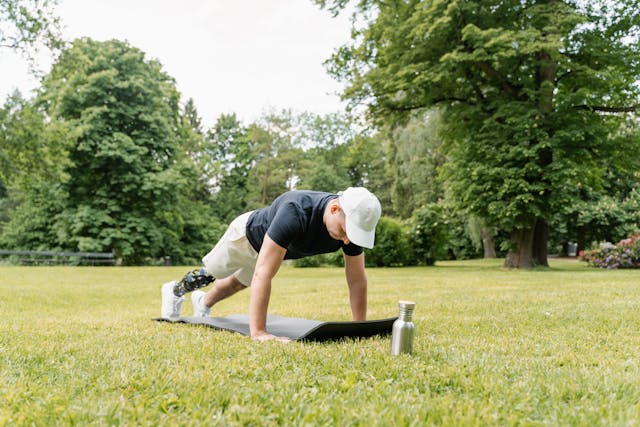
Traditionally, many prosthetic parts were made using heavy metals or basic plastics. While they were strong, they added extra weight that could cause fatigue, especially for transfemoral users. Now, with the introduction of carbon composites and advanced polymers, the weight has come down significantly—without reducing strength.
Lighter prosthetics make walking less tiring and improve balance. For above-knee users who need to manage both a knee and foot system, these lighter designs reduce stress on the hip and back. For below-knee users, the improved materials also make it easier to walk naturally for longer periods.
At Robobionics, we’ve started using lightweight, impact-resistant materials for both our sockets and foot components. The results have been immediate—less strain, better posture, and longer usage time without discomfort.
Flexible Designs That Adapt to the Body
In 2024, socket design has become more flexible. Instead of hard, rigid shapes, many sockets now include flexible inner linings or adjustable outer shells. This allows the socket to adjust with changes in the residual limb, such as swelling or muscle shifts throughout the day.
For transtibial users, this flexibility improves the way the prosthesis grips the leg, helping it feel more like a part of the body. For transfemoral users, these designs allow better thigh movement and reduce pinching or rubbing during long wear.
This type of material innovation means fewer visits for refitting and less discomfort from pressure points. It also gives users more freedom to move throughout the day without worrying about socket pain or irritation.
Softer, Skin-Friendly Interfaces
Another important innovation in 2024 is the improvement in the materials that come into direct contact with the skin. Liners made from medical-grade silicone or breathable gel blends are now more common. These materials reduce friction and heat while providing a gentle cushion between the limb and the socket.
Skin health has always been a concern for prosthetic users. With these newer materials, there’s less risk of blisters, pressure sores, or sweat buildup. The soft texture also makes it easier for new users to adjust to wearing a prosthetic full time.
Robobionics is introducing enhanced liners that keep the limb cool and dry, even during the Indian summer. These materials are hypoallergenic, easy to clean, and designed for all-day wear without irritation.
Smarter Knees and Feet for Smoother Walking
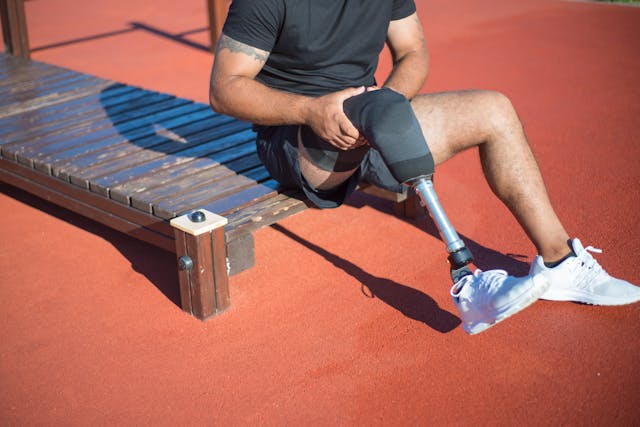
One of the biggest leaps in prosthetic innovation has come from how the foot and knee respond to movement. These parts are becoming more intelligent and responsive, helping users walk with more confidence and less energy.
Microprocessor-Controlled Knees Are Now More Accessible
A major update in 2024 is the wider availability of microprocessor knees. These knees use sensors and computer chips to adjust resistance based on how the user walks. They provide more stability when standing, and more freedom when walking on different surfaces like ramps, stairs, or uneven roads.
Previously, these knees were very expensive and mostly available in premium models. But this year, several new designs have entered the market with lower costs and simpler controls, making them accessible to more users in India and beyond.
For transfemoral users, this means fewer falls, better step control, and a more natural walking pattern. At Robobionics, we now offer knee systems that combine safety and intelligence—without making the device overly complicated or difficult to maintain.
Energy-Return Feet Improve Natural Movement
For transtibial users, the foot plays a key role in how smoothly and naturally the leg moves. The newest energy-return feet released in 2024 are designed to store energy when the heel strikes and release it as the foot pushes off. This creates a smoother, spring-like motion that mimics real walking.
These feet are lightweight and shaped for better ground contact. Some even include ankle flexibility, which helps with balance and slope walking. The result is that users feel more supported and less tired, even after walking long distances.
Robobionics is integrating these feet into many of our below-knee solutions, offering both basic and advanced models depending on the user’s lifestyle and activity level.
Smart Feedback Systems Are Now Emerging
Another exciting trend is the development of feedback systems that help users “feel” what the prosthetic is doing. Some new devices use subtle vibrations or pressure cues to let the user know how hard they’re stepping or if the knee is fully extended.
This helps users adjust their gait in real time, which improves walking efficiency and reduces strain. While still in early stages, these smart feedback systems are becoming part of more models, and they are expected to grow quickly by 2025.
Robobionics is keeping a close eye on these technologies and aims to introduce locally made, affordable feedback-enabled systems in the near future.
Personalization Through Digital Tools and 3D Design
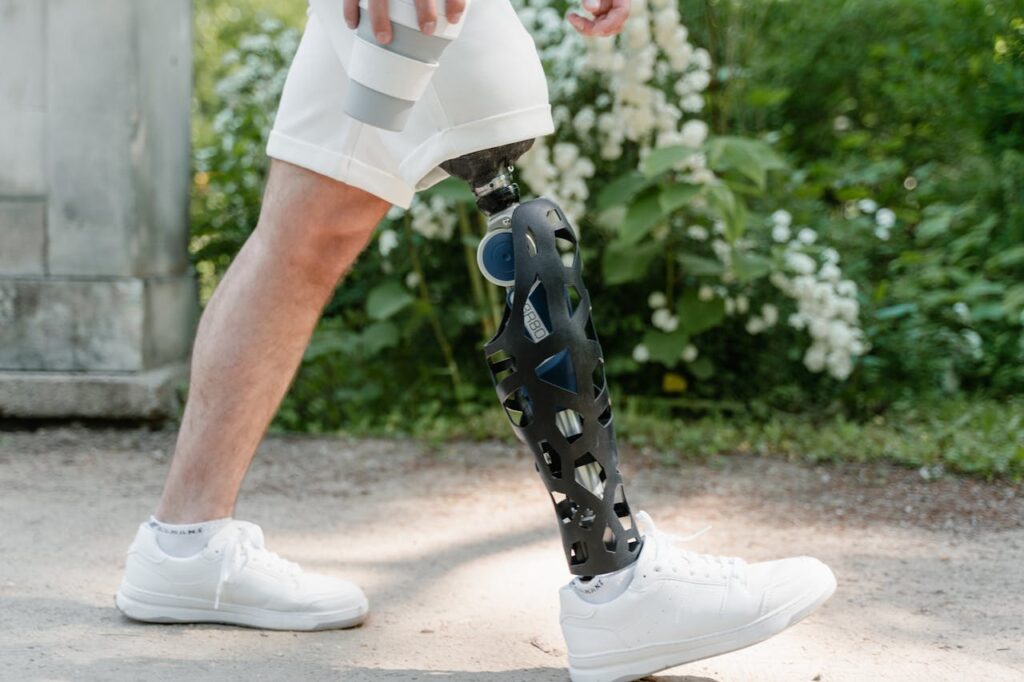
Prosthetics in 2024 are not just built—they are personalized using digital tools that make fittings more precise, faster, and more comfortable from the start.
3D Scanning for a Perfect Fit
Instead of relying on plaster molds and manual adjustments, many clinics now use 3D scanning to capture the exact shape of the residual limb. This process is faster, cleaner, and more accurate than traditional methods.
With a digital scan, the socket is designed on a computer, which allows the prosthetist to fine-tune pressure zones and contours before it is ever printed or built. The result is a better fit with fewer adjustments after delivery.
At Robobionics, we’ve adopted 3D scanning at our key partner clinics to ensure users receive a comfortable, well-fitted socket from day one. This helps reduce follow-up visits and makes the fitting process easier and more enjoyable.
Custom Designs for Real Life
Every person moves differently. That’s why digital tools now allow prosthetists to design sockets, pylons, and alignment angles that match the user’s posture, walking style, and daily needs.
For example, someone who walks long distances may need a foot with better shock absorption, while someone who works at a desk may benefit more from a softer socket that allows for long hours of sitting. These details can now be included in the design phase, thanks to digital modeling.
This year, Robobionics introduced flexible design templates that combine user feedback, 3D scans, and clinical data to deliver a prosthetic that matches both form and function with precision.
Quicker, Cleaner Production with 3D Printing
3D printing is not just a trend—it’s becoming the new standard. It reduces waste, shortens production time, and makes it easier to build complex shapes that fit the body better.
With 3D-printed sockets and components, users benefit from lighter, stronger designs made exactly for them. And because adjustments can be made on a computer, changes are faster and more cost-effective.
Robobionics continues to lead in India’s 3D-printed prosthetic space, offering personalized transtibial and transfemoral devices with high-quality materials and faster turnaround times.
Rehabilitation That Fits Modern Life
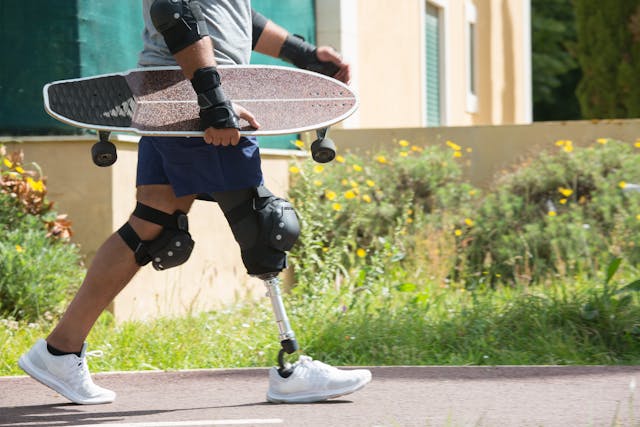
Innovation doesn’t stop with the prosthetic itself. In 2024, rehabilitation is becoming more accessible, engaging, and flexible—so users can train and recover at their own pace.
Home-Based Gamified Training Is Growing
One of the most helpful changes this year has been the rise of gamified home rehab programs. These are app-based or screen-based exercises that help users practice walking, balance, and coordination in a fun and interactive way.
By turning rehab into a game, users stay more engaged and motivated. Progress is tracked through levels or scores, making it easier to see improvement. It’s also ideal for those who can’t travel to rehab centers often.
At Robobionics, we offer gamified rehabilitation tools that work on mobile phones or tablets, allowing users across India to continue strengthening their muscles and improving gait without needing constant supervision.
Tele-Rehab Offers Personal Support Anywhere
Tele-rehabilitation allows users to connect with physiotherapists and prosthetists through video calls. This is especially helpful for follow-up checks, gait analysis, and personalized advice without visiting the clinic every time.
In 2024, more rehab professionals are trained in tele-rehab platforms, and many prosthetic users now receive a blend of in-person and remote care. This makes the process more flexible and reduces delays in recovery.
Robobionics partners with experienced therapists who guide users remotely, helping them stay on track with strength training, balance work, and proper prosthetic use from the comfort of home.
Adaptive Training Based on Real-Time Feedback
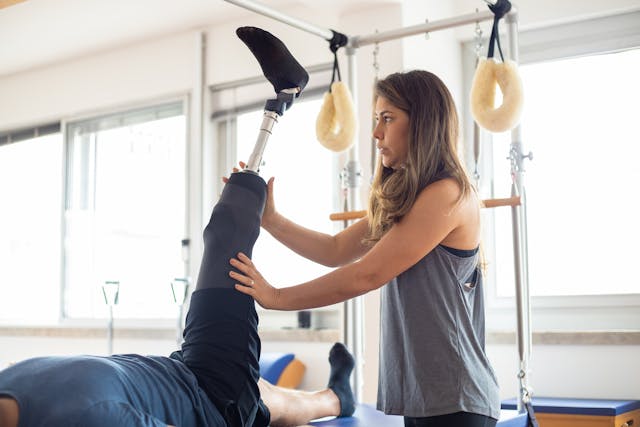
Some of the newest systems now include sensors that track how the user is walking in real-time. These sensors send data to a mobile app, where users and clinicians can view step counts, stride patterns, and pressure changes.
This data allows the rehab program to adjust automatically. If the system detects more pressure on one side, it might recommend a posture exercise. If the user is walking faster, it may unlock more advanced drills.
Though still developing, these real-time adaptive systems are expected to grow quickly. At Robobionics, we’re preparing to integrate this technology into our rehab plans in the coming year to improve outcomes and make training more personal.
Making Prosthetics More Affordable and Accessible in 2024
While technology continues to move forward, one of the most important challenges is making these innovations available to everyone—not just a select few. In 2024, more effort is going into affordability, accessibility, and local solutions that bring high-quality prosthetics within reach for users across India.
Reducing Cost Through Local Manufacturing
One of the biggest changes this year is the shift toward manufacturing prosthetics locally. By using Indian suppliers, local assembly teams, and in-house design, Robobionics has been able to significantly lower the cost of high-performance transtibial and transfemoral prosthetics.
This makes a big difference for users who would otherwise have to depend on imported devices. Not only are local solutions more affordable, but they also offer faster service and easier maintenance, which is critical for long-term comfort and reliability.
In 2024, more clinics and partners are turning to Indian-made devices to reduce wait times and lower repair costs. This “Make in India” movement is helping thousands of users regain mobility without breaking their budget.
Offering More Flexible Payment and Support Options

Understanding that cost is still a barrier for many, Robobionics has expanded its financing and support programs. In 2024, more users now have access to low-interest EMI plans, CSR-based funding, and rehabilitation packages that include both the prosthetic and aftercare.
We believe that everyone deserves a high-quality prosthetic that fits their life. That’s why we work with users from all walks of life, helping them find a solution that suits their budget, goals, and recovery journey.
This year, we’ve seen more users come forward, not just because the technology is better, but because the path to getting it has become more approachable and less overwhelming.
Faster Access Through Clinic Partnerships and Outreach
To make prosthetic care available across the country, Robobionics has partnered with certified clinics and rehabilitation centers to provide better access in both urban and rural areas. This network continues to grow in 2024, helping reduce travel time and making expert care more widely available.
We also run awareness and screening programs in underserved communities, helping people understand their options and guiding them through every step of the process—from evaluation to fitting to rehabilitation.
Our goal is simple: to make sure no one feels left behind when it comes to mobility. Whether you’re in a city or a small town, we’re working to bring the latest prosthetic innovations right to your doorstep.
Conclusion
The year 2024 has brought a powerful wave of innovation in transtibial and transfemoral prosthetics. From lighter materials and smarter knees to customized sockets and gamified rehab, these updates are changing lives in meaningful ways. But what makes this progress truly valuable is how accessible and user-focused it has become.
At Robobionics, we’re proud to be part of this shift—designing, building, and delivering prosthetics that are not just advanced but also comfortable, affordable, and designed for real life. Whether you’re walking for the first time or looking to upgrade your current device, there’s never been a better time to explore what’s possible.
Ready to experience the latest in prosthetic technology? Book a free demo or consultation with Robobionics today and take the next step toward better movement, better comfort, and better living.



